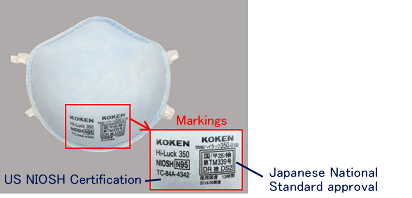
N95 Respirators
What is an N95 respirator?
An N95 respirator is a particulate-filtering facepiece respirator that meets the performance standards of the Code of Federal Register (42 CFR Part 84), which is evaluated and certified by the U.S. National Institute for Occupational Safety and Health (NIOSH).
In the 3rd version of the Guidelines for dealing with novel coronavirus infections in medical institutions published by the Japanese Society for Infection Prevention and Control, instead of surgical masks, the use of N95 respirators (or masks with filter performance equivalent to N95 respirator) or Powered Air-Purifying Respirators (PAPR) has been added as personal protective equipment for infection control in situations where large quantities of aerosols are likely to occur temporarily.* Accordingly, N95 respirators are used to protect healthcare professionals who are at the forefront of the response to the novel coronavirus infection from being infected.
※The situations in which aerosols are likely to occur are as follows: Tracheal intubation and extubation, airway suction, use of NPPV, tracheostomy, cardiac resuscitation, manual ventilation, bronchoscopy, nebulizer therapy, sputum induction, etc.
Performance Classification of Particulate Respirators in the U.S. Standards
NIOSH has currently established nine classifications of approved particulate filtering respirators based on a combination of the respirator's oil resistance and efficiency level as shown in Table 1.
Please note that the "N" stands for "Not resistant to oil," and "95" means that the respirator filters at least 95% of NaCl test particles.
Table 1 Performance Classification of Particulate Respirators in the U.S. Standards (42 CFR Part 84)

The current US standard testing procedures include the determination of inhalation resistance, exhalation resistance and exhalation valve leakage in addition to the determination of particulate filtering efficiency.
Japanese National Standards for Particulate Respirators
According to the national certification Standards for Particulate Respirators in Japan established by the Ministry of Health, Labor and Welfare, there are 12 classifications regarding the performance of particulate filtering efficiency as shown in Table 2. In these classifications, "DS2" corresponds to "N95." "DS2" D stands for disposable, S stands for Solid, and "2" means that 95% or more of the NaCl particulates are collected.
Table 2 Japanese National Standards for Particulate Respirators by the Ministry of Health, Labor and Welfare.

The current Japanese standard testing procedures include the determination of inhalation resistance, exhalation resistance, exhalation valve leakage and carbon dioxide concentration increase in inhaled air in addition to the determination of particulate filtering efficiency, for each of which acceptance criteria are set respectively.
Markings on N95/DS2 Respirators
Since the N95/DS2 respirator is obliged to carry a marking on the respirator indicating that it has passed the certification, checking for this marking is a necessary step in verifying that a respirator is a certified product.

Koken's N95/DS2 Particulate Respirators
In healthcare settings, we strongly recommend using Koken's Hi-Luck 350 respirator, an N95/DS2 respirator.


















